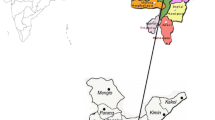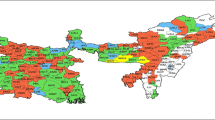Abstract
In this paper, a hybrid of seasonal autoregressive integrated moving average (SARIMA)-generalized autoregressive conditional heteroscedasticity (GARCH) was applied to eliminate conditional variance of the SARIMA model of rainfall time series in two different climatic environments (Agartala: humid, and Jodhpur: arid). In addition, the effectiveness of data normalization techniques (differencing and transformation) to stabilize conditional variance in the SARIMA residuals is additionally examined. The residuals from SARIMA models were tested for heteroscedasticity, utilizing the McLeod–Li test, and demonstrated some autocorrelation. Then, the rainfall time series was transformed (differencing and Box–Cox) so that the effect of heteroscedasticity is eliminated. The hybrid SARIMA–GARCH model based on transformed rainfall time series resulted in good statistics performance indices at both climatic environments. The findings of the study suggest that the performance of SARIMA models can be enhanced by using appropriate transformation (Box–Cox) along with GARCH model of residuals of highly skewed rainfall time series from both climatic environments. For Agartala station of monthly rainfall time series, the best model was SARIMA (0, 1, 1) (0, 1, 1)12–GARCH (1, 2) with coefficient of determination (R2) = 0.72 and root-mean-square error (RMSE) = 25.22, but after Box–Cox transformation of data, the best model was SARIMA (0, 1, 1) (0, 1, 1)12–GARCH (2, 4) with R2 = 0.87 and RMSE = 0.672. For the monthly rainfall series of Jodhpur station, the best model was SARIMA (0, 1, 1) (0, 1, 1)12–GARCH (1, 2) with R2 = 0.68 and RMSE = 16.75, but after Box–Cox transformation of data the best model was SARIMA (0, 1, 1) (0, 1, 1)12–GARCH (1, 2) with R2 = 0.79 and RMSE = 1.917. The performance indices indicate that hybrid (SARIMA–GARCH) models fitted to transformed time-series rainfall data performed best in the humid as well as the arid regions.







Similar content being viewed by others
References
Asar, O., Ilk, O., & Dag, O. (2017). Estimating Box–Cox power transformation parameter via goodness of fit tests. Communications in Statistics-Simulation and Computation, 46(1), 91–105.
Bera, A., & Higgins, M. (1995). On ARCH models: Properties, estimation, and testing. In L. Oxley, D. A. R. George, C. J. Roberts, & S. Sayer (Eds.), Surveys in econometrics (pp. 171–224). Cambridge: Blackwell Press, Oxford.
Bollerslev, T. (1986). Generalized autoregressive conditional heteroscedasticity. Journal of Econometrics, 31, 307–327.
Box, G. E. P., & Cox, D. R. (1964). An analysis of transformations. Journal of Royal Statistical Society Series B, 26, 211–252.
Box, G. E. P., & Jenkins, G. M. (1976). Time series analysis: Forecasting and control (Revised ed.). San Francisco: Holden-Day.
Brockwell, P. J., & Davis, R. A. (2002). Modeling and forecasting with ARMA processes in introduction to time series and forecasting. New York City: Springer.
Chang, X., Gao, M., Wang, Y., & Hou, X. (2012). Seasonal autoregressive integrated moving average model for precipitation time series. Journal of Mathematics and Statistics, 8(4), 500–505.
Engle, R. F. (1982). Autoregressive conditional heteroscedasticity with estimates of the variance of United Kingdom inflation. Econometrica, 50(4), 987–1008.
Hyndman, R. J., & Khandakar, Y. (2008). Automatic time series forecasting: The forecast package for R. Journal of Statistical Software, 26(3), 1–22.
Jha, V., Singh, R. V., & Bhakar, S. R. (2003). Stochastic modelling of soil moisture. Journal of Agricultural Engineering, 40(4), 51–56.
Kane, I. L., & Yusof, F. (2013). Assessment of risk of rainfall events with a hybrid of ARFIMA–GARCH. Modern Applied Sciences, 7(12), 78–89.
Kottegoda, N. T. (1980). Stochastic water resources technology. London: The Macmillan Press Ltd.
Livina, V., Ashkenazy, Y., Kizner, Z., Strygin, V., Bunde, A., & Havlin, S. (2003). A stochastic model of river discharge fluctuations. Physica A, 330(1–2), 283–290. https://doi.org/10.1016/j.physa.2003.08.012.
Ljung, G. M., & Box, G. E. P. (1978). On a measure of lack of fit in time series models. Biometrika, 65, 297–303.
Machiwal, D., & Jha, M. K. (2012). Hydrologic time series analysis: Theory and practice. New Delhi: Springer/Germany and Capital Publishing Company.
McLeod, A. I., & Li, W. K. (1983). Diagnostic checking ARMA time series models using squared residual autocorrelations. Journal of Time Series Analysis, 4, 269–273.
Mishra, A. K., & Desai, V. R. (2005). Drought forecasting using stochastic models. Stochastic Environmental Research and Risk Assessment, 19, 326–339.
Modarres, R., & da Silva, V. P. R. (2007). Rainfall trends in arid and semi-arid regions of Iran. Journal of Arid Environment, 70, 344–355.
Modarres, R., & Ouarda, T. B. M. J. (2012). Generalized autoregressive conditional heteroscedasticity modelling of hydrologic time series. Hydrological Processes, 27(22), 3174–3191.
Modarres, R., & Ouarda, T. B. M. J. (2013). Modelling heteroscedasticity of streamflow time series. Hydrological Sciences Journal, 58(1), 54–64. https://doi.org/10.1080/02626667.2012.743662.
Otache, M. Y., Ahaneku, I. E., Mohammed, A. S., & Musa, J. J. (2012). Conditional heteroscedasticity in streamflow process: Paradox or reality? Open Journal of Modern Hydrology, 2, 79–90. https://doi.org/10.4236/ojmh.2012.24010.
Pandey, P., Pandey, V., Singh, R. V., & Bhakar, S. R. (2009). Stochastic modelling of actual Black Gram evapotranspiration. Journal of Water Resource and Protection, 1(6), 448–455.
Rahman, M. R., & Lateh, H. (2015). Climate change in Bangladesh: A spatio-temporal analysis and simulation of recent temperature and rainfall data using GIS and time series analysis model. Theoretical and Applied Climatology, 128(1), 27–31.
Sun, H., Zhao, N., Zeng, X., & Yan, D. (2015). Study of solar radiation prediction and modeling of relationships between solar radiation and meteorological variables. Energy Conversion and Management, 105, 880–890.
Tol, R. J. S. (1996). Autoregressive conditional heteroscedasticity in daily temperature measurements. Environmetrics, 7(1), 67–75.
Toth, E., Drath, A., & Montanari, A. (2000). Comparison of short-term rainfall prediction models for real-time flood forecasting. Journal of Hydrology, 239, 132–147.
Wang, H. R., GAO, X., Qian, L. X., & Song, Y. U. (2012). Uncertainty analysis of hydrological processes based on ARMA–GARCH model. Science China Technological Science, 55(8), 2321–2331.
Wang, W., Van Gelder, P. H. A., Vrijling, J. K., & Ma, J. (2005). Testing and modelling autoregressive conditional heteroscedasticity of streamflow processes. Nonlinear Processes in Geophysics, 12, 55–66.
Weiss, A. A. (1984). ARMA models with ARCH errors. Journal of Time Series Analysis, 5(2), 129–143. https://doi.org/10.1111/j.1467-9892.1984.tb00382.x.
Yusof, F., Kane, I. L., & Yusop, Z. (2013a). Structural break or long memory: An empirical survey on daily rainfall data sets across Malaysia. Hydrology and Earth System Sciences (HESS), 17, 1311–1318.
Yusof, F., Kane, I. L., & Yusop, Z. (2015). Measuring volatility persistence on rainfall records with the hybrid of autoregressive fractional integrated moving average (ARFIMA)-Hidden Markov Model (HMM). AIP Conference Proceedings, 1643, 446–452. https://doi.org/10.1063/1.4907479.
Yusof, F., Kane, I. L., & Yusuf, Z. (2013b). Hybrid of ARIMA–GARCH modeling in rainfall time series. Jurnal Teknologi, 63(2), 27–34.
Yusuf, F., & Kane, I. L. (2012). Volatility modelling of rainfall time series. Theoretical and Applied Climatology, 113(1–2), 247–258.
Acknowledgment
Authors are grateful to the agencies that provided the data used in the present study. The authors appreciate the constructive comments from two anonymous reviewers, and we are grateful to Editor Dr. John Carranza for the valuable comments which substantially helped in improving the final version of the manuscript.
Author information
Authors and Affiliations
Corresponding author
Rights and permissions
About this article
Cite this article
Pandey, P.K., Tripura, H. & Pandey, V. Improving Prediction Accuracy of Rainfall Time Series By Hybrid SARIMA–GARCH Modeling. Nat Resour Res 28, 1125–1138 (2019). https://doi.org/10.1007/s11053-018-9442-z
Received:
Accepted:
Published:
Issue Date:
DOI: https://doi.org/10.1007/s11053-018-9442-z




